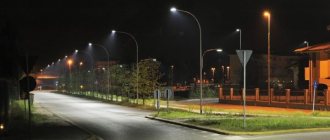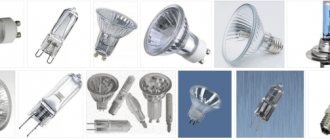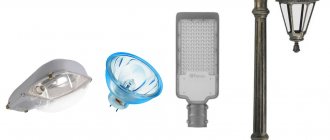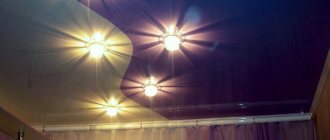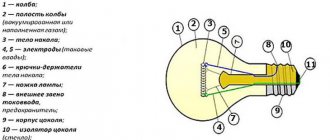Buying the right type of lamp for a lamp in a store is not such an easy task. What do you want from quality lighting first of all:
- comfort for the eyes
- energy savings
- harmless use
Type of base
Before purchasing a light bulb, it is first important to determine the required type of base. Most household lighting fixtures use two types of threaded base:
- base E-14 or minion
- base E-27
They differ accordingly in diameter. The numbers in the designation indicate its size in millimeters. That is, E-14=14mm, E-27=27mm. There are also adapters for lamps from one lamp to another.
If the lampshades of the chandelier are small, or the lamp has some specific features, then a pin base is used.
It is designated by the letter G and a number that indicates the distance in millimeters between the pins. The most common are:
- G5.3 - which are simply inserted into the luminaire connector
- GU10 - first inserted and then turned a quarter turn
The spotlights use the R7S base. It can be used for both halogen and LED lamps.
The lamp power is selected based on the limitations of the lighting fixture in which it will be installed. Information about the type of base and the power limitation of the lamp used can be seen:
- on the box of the purchased lamp
- on the lampshade already installed
- or on the light bulb itself
Color rendering index
The third parameter describes how colors are perceived under artificial light, because light can distort them. This is important not only for the designer’s work with color, but also in order to accurately see the color of clothing and makeup in the mirror. For example, if you have lamps with distorted color rendering, then a blouse that was burgundy in the store will turn out to be red-scarlet at home, or blondes will have a greenish tint in their hair.
The color rendering index can be specified in two ways: Ra and CRI (color rendering index). The number in this case is a percentage: so, 100% is the sun, and lamps are now capable of a maximum of 95%. For correct color rendering, the optimal value is at least 80 Ra/CRI. Unfortunately, Chinese manufacturers may indicate this data incorrectly, so if you don’t want to make a mistake, it is better to use lamps from well-known brands. If this index is not on the packaging, this clearly indicates an unreliable manufacturer - you can buy a pig in a poke.
Flask shape
The next thing you need to pay attention to is the shape and size of the flask.
A flask with a threaded base may have:
- pear shape
- ball of different diameters
- or the shape of a candle for narrow chandelier shades and sconces
Pear-shaped ones are designated by the nomenclature - A55, A60; ball ones - with the letter G. The numbers correspond to the diameter. Candles are marked with the Latin letter - C.
A bulb with a pin base has the shape:
- small capsule
- or flat reflector
When is it better to install high-brightness lamps in headlights?
If you often drive in the dark or have poor eyesight, pay attention to the Night Breaker series lamps. They are designed to significantly improve visibility and illumination on the road. OSRAM Night Breaker 200 halogen lamps are the brightest OSRAM halogen lamps . They are best placed in headlights if you want to see much more. Increased visibility allows you to see objects on the road much further and react to hazards faster, making driving safer. But be prepared for the fact that these lamps will have to be changed more often than usual . Increasing the brightness of halogen lamps entails a decrease in their resource.
Lighting standards
Lighting brightness is an individual concept. However, it is generally accepted that for every 10 m2 with a ceiling height of 2.7 m, a minimum illumination equivalent of 100 W is required.
Illumination is measured in lux. What is this unit? In simple words, when 1 lumen illuminates 1 m2 of room area, then this is 1 lux.
The standards differ for different rooms.
Illumination depends on many parameters:
- from distance to light source
- colors of surrounding walls
- reflection of light flux from foreign objects
Illumination can be measured very easily using standard smartphones. All you need to do is download and install a special program. For example – Luxmeter (link)
True, such programs and phone cameras usually lie compared to professional light meters. But for household needs, this is more than enough.
Brightness comparison
Which sources have the best energy-saving indicators, LED or fluorescent?
With the same luminous flux, LED lighting devices consume less power than fluorescent ones. In addition, luminescent energy-saving devices do not tolerate frequent switching on. Their harmful effects on humans have not yet been sufficiently studied. In this regard, LED light bulbs, which are absolutely safe for human health, are currently becoming increasingly popular.
LEDs are the brightest lighting sources. For example, the luminous flux of a 4-8 W LED bulb corresponds to the flux of a 40 W or 60 W incandescent lamp.
We will find out from the table which devices will shine brighter, LED or halogen.
It is obvious that in comparison with halogen, fluorescent and incandescent lamps, the brightest lighting sources are LEDs.
Incandescent and halogen bulbs
The classic and most inexpensive solution for lighting an apartment is the familiar incandescent lamp, or its halogen version. Depending on the type of base, this is the most affordable purchase. Incandescent and halogen bulbs provide comfortable, warm light without flickering and do not emit any harmful substances.
However, it is not recommended to touch the bulb with your hands for halogen lamps. Therefore, they must come packaged in a separate bag.
When a halogen light is lit, it gets very hot. And if you touch its bulb with greasy hands, residual stress will form on it. As a result of this, the spiral in it will burn out much faster, thereby reducing its service life.
In addition, they are very sensitive to power surges and often burn out because of this. Therefore, they are installed together with soft start devices or connected via dimmers.
Halogen lamps are mostly manufactured to operate from a single-phase network with a voltage of 220-230 Volts. But there are also low-voltage 12-volt ones that require connection via a transformer for the appropriate type of lamp.
A halogen lamp shines brighter than a regular one, by about 30%, but consumes the same power. This is achieved due to the fact that it contains a mixture of inert gases inside.
In addition, during operation, particles of tungsten elements are returned back to the filament. In a conventional lamp, gradual evaporation occurs over time and these particles settle on the bulb. The light bulb dims and works half as hard as a halogen light bulb.
Types of energy-saving light bulbs for the home
Compact fluorescent light bulbs, abbreviated as CFLs, are called energy-efficient. The abbreviation will be used throughout the text.
By design, this is a conventional fluorescent light source in a more compact format. The power supply is installed at the base of the case near the plinth; for cooling, small holes are made through which air circulates.
- Main varieties:
- shape in the form of a spiral, circle, square, horseshoe;
- base E14, E27, E40;
- with a flask in the shape of a pear, candle, ball;
- Possibility of brightness control, dimming.
If you decide to switch from CFLs to LEDs, you will encounter a common problem. For LEDs with an E14 base, the luminous flux is no more than 600lm, due to the fact that the sizes are limited. The power in this case is 6-7W, this is almost analogous to a 60W incandescent.
LEDs may not be enough to illuminate a room where CFLs previously stood. The illumination will be lower than expected, but it should be with a margin, taking into account the degradation of LEDs. Even the Chinese don’t have powerful ones, although they write in parameters from 1000 to 1500 lm, which is 2-3 times too high.
Only recently E14 LEDs with 800-900 lumens, power consumption 10W, produced by X-Flash have appeared. But now they are in short supply, E14 at 10W are sold out immediately, they are not even often available on the manufacturer’s website.
- The main disadvantage of CFLs will be:
- slow ignition for up to 10 minutes;
- reduced light output at low temperatures.
How to choose energy-saving light bulbs
To choose the best energy-saving lamps you need to know 9 basic parameters, half are similar to diode ones.
- Main characteristics:
- rated power - energy consumption;
- power factor - the ratio of active and reactive;
- luminous flux – source brightness;
- color temperature – 2700K warm white or neutral white 4000K;
- color rendering index CRI – color rendering of objects;
- warm-up time - the period of time after which it shines by 60-80%;
- ignition time – time required for ignition;
- service life - the number of hours after which the brightness will drop by 30% of the initial value;
- number of switching cycles.
The easiest way to choose the best is by brand, it should be well-known. If you are hearing the brand name for the first time, it is better to refuse. The larger the brand, the more they worry about quality.
When you compare energy-saving ones in price with cheap diode ones, then in terms of service life they will not work much longer than CFLs. A good LED costs from 200 rubles.
Consider the installation location; if it’s on the street or in the entrance, there will be many people who want to steal it or break it. That’s why I put filament LEDs with a broken bulb in the entrance; they can’t be unscrewed without a tool. If you try to twist it by hand, you will break the LEDs, and it’s not very noticeable in the lampshade.
Color rendering and luminous flux
The advantage of conventional incandescent lamps is a good color rendering index. What it is? Roughly speaking, this is an indicator of how much light close to solar light is contained in the scattered flux.
For example, when sodium and mercury lamps illuminate the streets at night, it is not entirely clear what color people’s cars and clothes are. Since these sources have a poor color rendering index - around 30 or 40%. If we take an incandescent lamp, then the index is already more than 90%.
Currently, the sale and production of incandescent lamps with a power exceeding 100W is not permitted in retail stores. This is done for reasons of preserving natural resources and saving energy.
Some people still mistakenly choose lamps based on the power labels on the packaging. Remember that this number does not indicate how bright it shines, but only how much electricity it consumes from the network.
The main indicator here is luminous flux, which is measured in lumens. This is what you need to pay attention to when choosing.
Since many of us previously focused on the popular power of 40-60-100W, manufacturers for modern energy-saving lamps always indicate on the packaging or in catalogs that their power corresponds to the power of a simple incandescent light bulb. This is done solely for the convenience of your choice.
How to choose lighting lamps?
In modern conditions, you come to a store and see a long display in the lighting department. Already at this moment it becomes clear that the choice is very complicated by the huge assortment. Now there is no shortage and lighting lamps for the home are very widely represented. The lines of lamp models from some manufacturers are so long that without specific requirements for lamps, their choice may become impossible simply for the reason: “I don’t know what I need.” Of course, you could get your bearings based on the light bulbs that were used before, or on the recommendations of friends. But! What if you previously only used incandescent bulbs, but due to the need to reduce energy costs, or due to a design decision, you need to choose LED lighting? Let's start in order.
Luminescent - energy saving
Fluorescent lamps have a good level of energy savings. Inside them there is a tube from which the flask is made, coated with phosphor powder. This provides a glow 5 times brighter than incandescent lamps at the same power.
Luminescent ones are not very environmentally friendly due to the coating of mercury and phosphor inside. Therefore, they require careful disposal through certain organizations and containers for receiving used light bulbs and batteries.
They are also subject to flicker. This is easy to check; just look at their glow on the display through your smartphone’s camera. It is for this reason that it is not advisable to place such light bulbs in residential areas where you are constantly present.
What is better: LED lamps or energy-saving ones
So, which lamp is better: LED or energy-saving? This question can be answered by looking at a brief comparison between them.
In terms of service life, LED lamps are significantly ahead of energy-saving lamps. For 80 - 100 thousand hours of burning LED lamps (about 8 years), energy-saving ones burn for 4 - 12 thousand hours (from 3 to 4 years).
The LED lamp is not afraid of frequent switching on and off; it “lights up” immediately after switching on. “Start - warm-up” energy-saving is 1 minute, although this is a minor minus. Both lamps practically do not heat up and are completely fireproof.
For human health, LED lamps are preferable; they do not contain harmful components, while energy-saving lamps contain mercury, which for some consumers is a deterrent when purchasing.
When there is low power or frequent power fluctuations in the network, an energy-saving lamp may simply refuse to work, which cannot be said about an LED lamp, although its service life is reduced by up to 25%. In terms of power consumption, LED lamps are more energy efficient. Also, economy lamps require special disposal.
Well, and of course the price. In this matter, the LED is inferior to its leading position to the energy-saving lamp, although its cost is more than compensated. After studying this comparison, you will certainly be able to determine for yourself which light bulbs are better, LED or energy-saving, and make the right choice of lighting for your beautiful chandelier.
If you look for differences in these two lamps, it will turn into some kind of absurdity. The thing is that, according to their operating principles, both lamps are completely different. The only thing they have in common is that both LED and energy-saving ones provide light.
Despite the fact that we would like to bypass the cornerstone of the features of lamps, we still have to summarize something, if only in order to make a final conclusion about which type to prefer when purchasing. It is these interesting features related to each type of lamp that we will talk about further.
LED light bulbs
Since the bulk of the electrical energy in our houses and apartments, except those equipped with stationary electric stoves, is consumed for lighting, replacing incandescent lamps with energy-saving ones will significantly save money.
The LED lamp, unlike incandescent lamps, has a number of undeniable advantages. The luminous efficiency of such a lamp is 5 times greater than that of a conventional incandescent lamp, which makes it possible to reduce energy consumption by up to 80%, for example, replace a 100-watt incandescent lamp with an LED analogue of 12–20 watts.
An LED lamp lasts up to 50 thousand hours, and an incandescent lamp, according to technical indicators, will last up to a maximum of 1.5 thousand hours, although in practice it is even less. If we compare in terms of kWh savings, then based on the number of lamps, hours of burning and power, savings from 50 to 100 kWh can be achieved per month.
Typically, consumers are “scared” by the price of an LED light bulb, the average cost of which varies among suppliers from 100 rubles. for one 12 watt lamp.
The average price of a regular 100-watt incandescent lamp is 20 rubles. But, if we take into account the service life, then for the period of operation of the LED lamp of 50 thousand hours, you will have to purchase up to 50 pieces of incandescent lamps, with a total cost of 1000 rubles. And this difference will really help you save money.
It is worth purchasing LED lamps based on the payback period. Thus, according to experts’ calculations, with an electricity consumption of up to 100 kWh per month, a 12-watt lamp will pay for itself in a little more than a year, with a monthly consumption of 100 to 600 kWh - about 2.5 years.
Energy saving light bulbs
Energy-saving fluorescent lamps are in great demand among consumers on the market.
Unlike an incandescent lamp, where light is converted by passing electrical energy through a tungsten filament, light in an energy-saving lamp is converted from the ultraviolet glow of a gas discharge, which is formed by passing an electrical discharge through the gas filling the bulb.
The advantages of fluorescent lamps include light output, economical energy consumption, they heat up less and have a long service life. Consumers often complain that lamps burn out much faster than the service life declared by the manufacturer.
Why do energy-saving lamps burn out quickly?
The service life of fluorescent lamps is affected by operating rules; they cannot be turned on and off frequently, and power surges in the network are also negatively affected. That is, it is not always necessary to blame the quality from the manufacturer; sometimes energy-saving ones burn out due to improper operating conditions.
Also, energy-saving lamps should not be touched with your hands, because you will simply leave fat on their surface, which in turn will lead to burnout. If you accidentally touch the surface of such a lamp, wipe its surface with a lint-free cloth soaked in alcohol.
Energy-saving lamps also contain mercury. If you accidentally break a lamp, carefully assemble everything, do a wet cleaning with a solution of potassium permanganate and ventilate the room well. Burnt-out lamps cannot simply be thrown into the trash; they are subject to mandatory disposal by specialized enterprises.
LED
LED lamps and lamps of various shapes and designs are widely used in various spheres of life.
Their advantages:
- resistance to temperature overloads
- negligible effect on voltage drops
- ease of assembly and use
- high reliability under mechanical loads. There is minimal risk that it will break if dropped.
LED lamps heat up very little during operation and therefore have a lightweight plastic body. Thanks to this, they can be used where others cannot be installed. For example, in suspended ceilings.
Energy savings from LEDs are greater than from fluorescent and energy-saving ones. They consume approximately 8-10 times less than incandescent lamps.
If we roughly take the average parameters for power and luminous flux, we can obtain the following data:
These results are approximate and in reality will always differ, since much directly depends on the voltage level, manufacturer brand and many other parameters.
For example, in the USA, in one fire station, an ordinary incandescent light bulb, which is already more than 100 years old, is still burning. There was even a special website created where you can watch her online through a web camera.
Everyone is waiting for it to burn down in order to record this historical moment. You can view it here.
Low pressure sodium lamps (LPNS)
These are the brightest light sources, with a luminous efficiency of 200 Lm/W. The principle of operation of the device: sodium vapor, passing an electric current through itself, begins to glow yellow-orange. The internal flask of the NLND is made of borosilicate glass, resistant to aggressive environments.
Positive traits:
- high light output;
- long service life reaching 28,000 hours;
- comfort of color radiation;
- wide range of operating temperatures, from – 60 to + 40 degrees Celsius;
Negative qualities:
- presence of mercury;
- Explosion hazard; contact with air may cause fire;
- inertia when turned on;
- complexity of connection and maintenance;
- low level of color rendering;
- increased pulsation of light flux in the network 50 Hz;
- high ignition voltage and even higher when restarting;
- increase in power consumption during operation.
Despite the fact that low-pressure sodium lamps can shine brighter than others, and in terms of efficiency they are in first place, they are used only in places where people temporarily stay, illuminating:
- open spaces, streets, highways,
- tunnels, sports facilities, squares,
- architectural structures, airports.
NLND is used in automobile fog lights to improve visibility on roads, in warehouses and in other places where high color rendering is not necessary.
Light flow
LED and energy-saving lamps have the ability to produce different colors of light output.
- warm yellow
In this case, it will indicate the value 2700-3500 Kelvin. This is the so-called color temperature. This light is similar to simple incandescent light bulbs. Yellow is the most comfortable for the eyes and cozy for life.
- day white
The lamp indicates 3500-4500 Kelvin. This light is good where correct color rendition is needed - a desktop, applying makeup, artistic work.
- bluish-cold 6400 Kelvin and above
This light would be appropriate in a bathroom or utility room.
In order not to look for incomprehensible numbers and quickly distinguish the amount of luminous flux, manufacturers often put visual color codes on the packaging:
- blue frame – cold light
- yellow – warm
Which lamps are most convenient and useful for a home or apartment?
Of course, it is impossible to definitively answer the question of which light bulbs are best for use in household electrical appliances. Firstly, it is difficult to focus only on cost, brightness, power consumption, color temperature or some other indicator. Secondly, different options are preferable for different rooms and devices:
- the most comfortable light for the eyes is produced by incandescent lamps, but they “burn” a lot of electricity;
- fluorescent lamps are economical, but tire the eyes;
- halogens are economical and bright, but they are not recommended for use in bedrooms and children's rooms;
- LED lamps are good in many respects, but they are expensive.
For a deeper understanding and easy comparison, check out the following table.
Light characteristics of light sources that you should pay attention to when purchasing
A modern approach to lighting devices allows us to take into account three groups of requirements for the design of premises:
- general illumination of the workplace;
- the impact of created light on human health;
- economic indicators that determine cash costs.
What determines the illumination of a workplace?
A single light bulb produces a luminous flux measured in lumens. It is indicated by the manufacturer in the accompanying documentation.
This luminous flux is distributed over the surface of the working area and forms its illumination, expressed in lux.
Since several light sources are usually used in a room, the total illumination from them is calculated using a special formula.
The influence of lighting quality on human health
The color spectrum has a different effect on our body: it excites or tones it, or creates a calming effect.
This feature allows you to take into account the color temperature, marked in degrees Kelvin. It is usually listed on the packaging box of the lamps.
Also, when choosing light bulbs, it is necessary to take into account the sensitivity of the human eye to the wavelength of light. It is expressed in conventional units.
Economic indicators from various sources
The electrical energy consumed by the lamp is converted not only into the visible spectrum of illumination, but is also added to it:
- ultraviolet;
- infrared;
- thermal radiation.
As a result, for 1 watt of electrical power expended, all types of lamps create different levels of illumination, called luminous efficiency.
It is lowest for incandescent filaments and highest for LEDs.
Put a lamp in the headlight and forget about it? Choose Ultra Life!
OSRAM Ultra Life halogen lamps are designed to provide the longest service life possible for halogen automotive lamps. Their luminous flux is standard, but they will work four times longer than conventional lamps . In addition, these are the only halogen lamps that come with a 4-year OSRAM warranty. An ideal choice for drivers who want to install lamps in their headlights and never think about them again!


